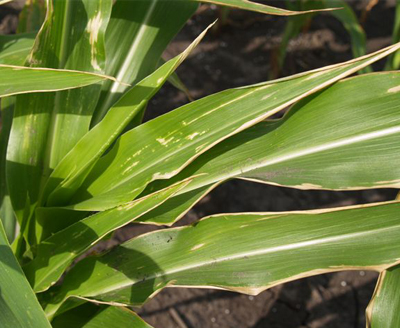
- Delaying N applications later into the growing season may result in disappointing harvest yield (N deficiency) and a greater risk of having residual N in the soil profile after harvest.
- All sources of post-applied N are equally as effective when proper management of the source is considered.
- The burn from broadcast post-applied urea is not necessarily a direct fertilizer burn.
- All Nitrogen forms are in-line with N-BMP’s.
When is a good time to plan for post-emerge N applications. There is no reason to delay post-emerge N applications on medium-to-heavy textured soils. As soon as field conditions allow, post-emerge N should be applied. Nitrogen must move into the plant with soil water. The longer a post-application of N is delayed, the greater will be the risk of not receiving adequate rain to get the N into the plant. Delaying N applications later into the growing season may result in disappointing harvest yield (N deficiency) and a greater risk of having residual N in the soil profile after harvest, depending upon soil moisture received after any delayed application. If water can be controlled, delayed applications make more sense. However, typical mid-season rainfall in the central part of the Midwest is impossible to predict and delaying N applications may be risky.
Is one source of post-applied N better than the other? A pound of N is a pound of N whether applied as urea, UAN or anhydrous ammonia. All sources of post-applied N are equally as effective when proper management of the source is considered. Marketing and infrastructure (equipment capabilities and fertilizer storage) are usually the reasons one source is favored over the other, not because of performance.
What type of burn should be expected from post-applied urea? The burn from broadcast post-applied urea is not necessarily a direct fertilizer burn. Symptoms will usually develop a day or two after application and will be more obvious on the newer leaf tissue (leaf after application). The burn will be associated with leaf margins (Figure 1). The exact mode of burn has yet to be defined but is thought to be related to N accumulation at the leaf margins due to the evaporation of water carrying urea at the leaf’s edge, reaching levels high enough to induce the characteristic marginal scorching. The degree of leaf margin burn appears to be related to the temperature and humidity the day of and after the application. The leaf burn is nearly always cosmetic (if apparent) and no yield loss should be anticipated.
What forms of post-applied nitrogen match BMP’s for N use? All forms are in-line with N-BMP’s. Urea or UAN treated with a NBPT based urease inhibitor (e.g. Agrotain ) and surface-applied are a safe and reliable option for post-N applications to corn. Consistent yield response of broadcast post-applied urea with NBPT has been documented over the past five years, where supplemental N was needed. Broadcast urea is evenly distributed and readily available to corn roots once carried into the soil surface by rainfall. If the corn plants will respond to supplemental N applications, urea treated with NBPT will not be disappointing. UAN likewise is still a reliable source of post applied N, and remains a popular choice. UAN and NBPT dribbled between the rows does take a little longer for corn roots to reach it as roots need to grow and the UAN needs rain to disperse it from the point of application. Anhydrous ammonia remains an old standby. Anhydrous ammonia applied as a liquid quickly dissipates in the soil to a gas as it quickly seeks out soil moisture to associate with. Once dissipated and in soil solution it is readily available for plant uptake.
[1] Trademark of KOCH Agronomic Services, LLC
Figure 1. Leaf marginal burn from post-emergeapplications of urea treated with NBPT.